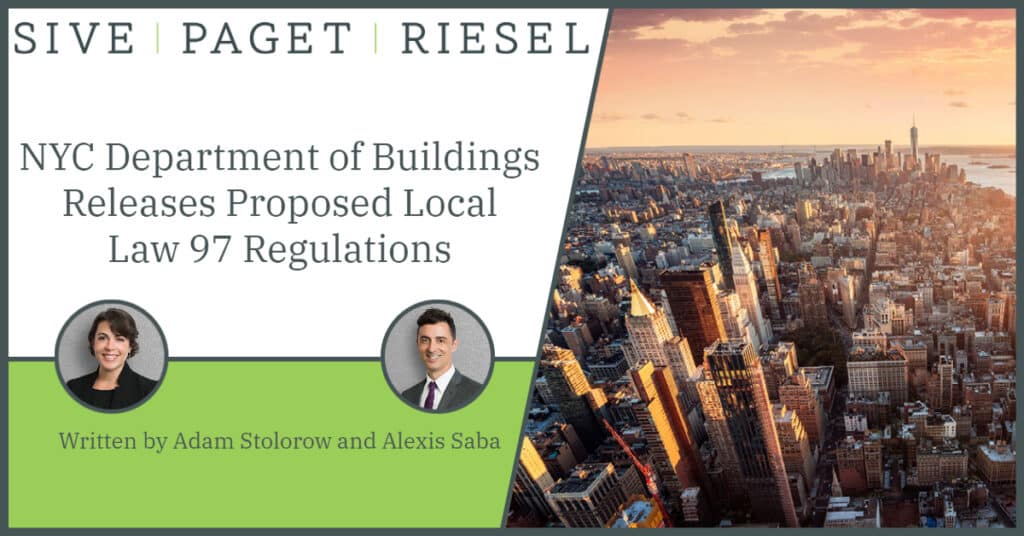Blog

NYC Department of Buildings Releases Proposed Local Law 97 Regulations
On October 6, 2022, the New York City Department of Buildings (DOB) issued proposed regulations to implement Local Law 97 of 2019 (LL97). LL97 requires most large buildings in NYC to meet increasingly stringent greenhouse gas (GHG) emissions limits starting in 2024. The proposed regulations include three key components and numerous other clarifications to the law, including the establishment of GHG coefficients for the 2030-2034 compliance period. DOB is accepting public comments on the new regulations through November 14.
One of the most impactful elements of the proposed DOB rule is the detail on building emissions calculations. A building’s emissions are generally calculated by multiplying the amount of energy (electricity and fuel) used in the building by the GHG coefficient assigned to each energy source. LL97 only established GHG coefficients for the first compliance period (2024-2029). The proposed DOB rule sets forth the GHG coefficients for utility electricity and fuel for the second compliance period (2030-2034), as well as establishes GHG coefficients for numerous types of fuel consumed on the premises (such as gasoline, kerosene, etc.). Notably, the proposed GHG coefficient for utility electricity in 2030-2034 is half of what it is for 2024-2029. This drop reflects the decarbonization of the electrical grid in New York state under the Climate Leadership and Community Protection Act (CLCPA), which requires 70% renewable energy in the grid by 2030. The proposed DOB rule also includes GHG coefficient calculations for electricity based on time of use, campus-style systems, and distributed energy resources (including combined heat and power, off-site solar, and energy storage).
The proposed DOB rule also refines the calculations used for setting emission limits for each building covered by the law. A building’s emissions limit is calculated by multiplying the square footage of each occupancy group within the building by the GHG coefficient assigned to those occupancy groups. LL97 used the occupancy groups identified in the NYC Building Code; however, this component of the law has been criticized as not accounting for wide variations in energy use among different use types falling within the same occupancy group. The proposed DOB regulations would instead use the Energy Star Portfolio Manager property types, which are more detailed than the NYC Building Code occupancy groups and are intended to capture the differences in energy usage among narrower subsets of property types than those identified in the NYC Building Code. The proposed DOB rule also sets forth the GHG coefficients for property types through 2050; zero GHG emissions across all property types will be required by and after 2050.
Finally, the proposed DOB rule clarifies the scope of allowable deductions from building emissions. Most notably, the proposed rule significantly limits the application of renewable energy credits (RECs) by allowing building owners to use RECs to offset only utility-supplied electricity, not on-site fuel consumption. This restriction will likely impact residential buildings most, as they tend to consume more fuel and less electricity than do commercial buildings. The proposed DOB rule also provides detail on the deduction for clean distributed energy resources, which include electricity generation and storage systems. In particular, for solar energy systems located on the building premises and that export electricity to the grid, the amount of exported electricity can be deducted from the total utility electricity consumed by the covered building in the reporting year.
The proposed DOB rule also includes details on other topics of interest to the regulated community and other stakeholders, such as the treatment of electrical use associated with electric vehicle charging, the reporting requirements for mid-year changes in building status (such as new construction, demolition, and ownership changes), and the expiration of emissions limit adjustments. Notably, the proposed DOB regulations do not clarify the emissions limit enforcement process, including how the City will apply penalty mitigation factors and adjudicate building owners’ challenges to penalty assessments.
DOB will hold a virtual public hearing on the proposed rules on November 14 at 11:00 am and will close the on-going public comment period that day. SPR will continue to track this developing area of law, with updates available on our Blog and LinkedIn page.